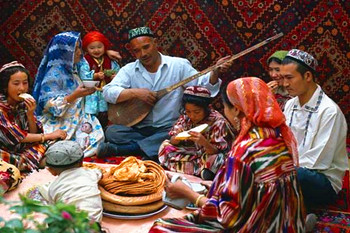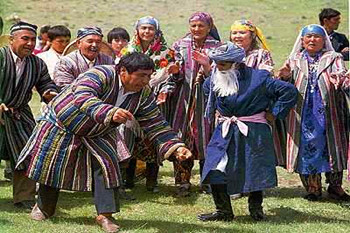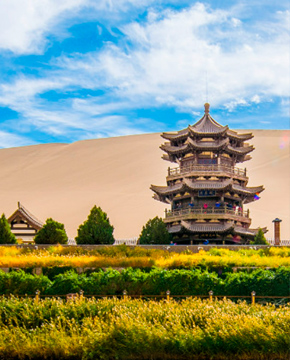Vast territory, long history, and the ancient Silk Road, all this makes Xinjiang a large stage for a variety of ethnic peoples and diverse cltures to develop and present themselves. Ethnic groups have lived there harmoniously and created extraordinary history and splendid cultures as well as unique national charm. Nowadays, there are 47 ethnic nationalities in Xinjiang, mainly Uygur, Han, Kazak, Hui, Mongolian, Kirkiz, Xibo, Tajik, Uzbek, Manchu, Russian, Daur and Tatar.
Uygur:
The Uygur nationality has a population of over 8 million, the majority of them live in compacted communities of the areas to the south of Tianshan Mountains, such as Kashgar, Hotan and Aksu, and the rest inhabited in Ili prefecture and other places in the northern part of Xinjiang.
The Uygurs believe in Islam, which is their dominant religion since the tenth century. Furthermore, they have their own spoken language. It belongs to the Turkic Group of the Altaic Language Family. The Uygurs have created and developed their own culture during the long and well-documented history in which classical epics and the great work, such as The Dictionary of Turkic language, are the symbols of their splendid culture.
xinjiang Uygur men usually wear a long gown, known as gapan, with a tilted front and waistband but no button. Women like wearing broad-sleeved piece dresses. Girls always dressed their hair into many small braids. The Uygur people, both old and young, men and women, like to wear the four or five angled embroidered hat. The Uygur hats, known as ‘Dopa', are exquisite handicrafts with bright colors and various design. The style varies based on different districts, genders of wearers, and their professions. In addition, the Etles sat in for women' s dress and Yengisar knives brought by men are superior handicrafts.
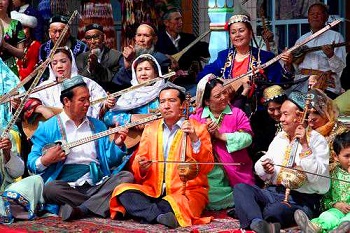
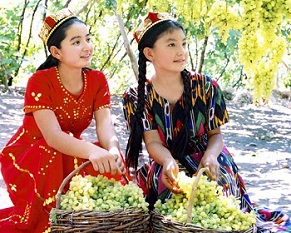
Kazakh:
The The Kazakh has a long history. As early as the Han Dynasty , Wusun people, a nomadic people, were believed as one of the ancestors of Kazakh.
Expect for a few settled farmers, most of the Kazakhs live on husbandry production production. The migrate to look for pastures as the seasons change, leading a nomadic life. The Kazakh is proud of horse riding. Grazing , transportation, expedition, and even their life depends heavily on horses. Therefore, they are named "A nationality on the horseback". In spring, summer and autumn, they live in collapsible round yurts and in winter in flat rooted earthy or wood houses in pastures. In the yurts, living and storage spaces are separated. The yurt door usually opens to the east. They ride for business and some take sleighs in winter.
Their diet mainly contains meat, food made by flour and diary products, in which mutton is the top choice and the horse meat is the best. Horse intestine, cheese and koumiss are their special food. Moreover, Kazakhs will not live without milk tea for a single day
Kazakh's arts have a great variety, including crafts, music and dance. In terms of crafts, there are sculpture, embroidery and picture design. The two stringed instrument, "Dongbula", is their favorite.
Kirkiz:
The Kirkiz nationality, with a population of 254,000, finds most of its inhabitants in the Kizilsu Kirkiz Autonomous Prefecture in the southwestern part of the Xinjiang.
The yurts are the main dwellings of Kirkiz herders, made of felts, called ‘Boziwu'. The settled Kirkizs mostly live in flat-roofed square mud houses. The Kirkizs are very hospitable and ceremonial. A visitor is invariably entertained with the best-mutton. Offering mutton from the sheep's head shows the highest respect for the guest. At the table, the guest is the first to be offered the sheep tail fat, shoulder blade mutton and then the mutton from the head.
Their diet mainly consists of milk and dairy products. Horse milk,milk, butter, yogurts are their daily food. The Kirkiz are fan of drinking a beverage ‘yarma' made by fermented barley and wheat. In addition,they are also fond of boiled tea with milk and salt.
At the beginning of the first month of the year (20/21 March, the Gregorian Calendar ), the Kirkiz people celebrate their traditional festival, ‘Nawurez' Apart from this festival, they also celebrate the Islamic festivals, such as Fast-breaking or Eid-ul-Fitr and the Corban Festivals.
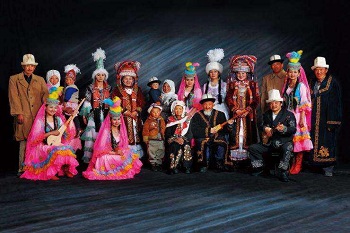
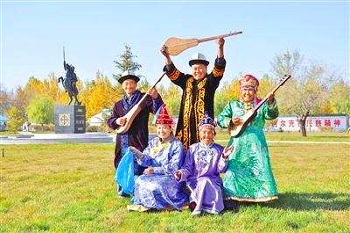
Mongolians:
With a population of 180,000, most of the Mongolians in Xinjiang live in Bayinguoleng and Bortala Mongolian Autonomous Prefectures and Hebukeser Mongolian Autonomous County.
Mongolians were nomads. Beef and mutton, dairy products and food made by flour are their staple food. They like making milk wine with cow's and sheep's milk. Their clothes are of Mongolian gowns. In pastoral areas Mongolian herdsmen live in yurts, which were usually seven to eight feet high and ten feet in diametre. By the way, Mongolians believed in Shamanism.
Hui:
With a population of 730,000, the Hui mainly live in the area of Changji Hui Autonomous Prefecture, Miquan, Yining City, Huocheng City, Urumqi, Yanji Hui Autonomous County and Turpan region. Because living with Han and other minorities for quite long time, their costumes are almost the same style as the local people. In the Hui communities, men over mid age wear small white hats, white cotton shirts and black shawls while women put on white or blue caps. The old women like wearing black cotton padded jackets with stringed bottoms of trousers legs.
The Hui people believe in Islamism, they are characterized by observing tradition and convention, they do not eat pork.
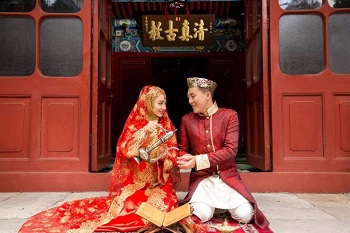
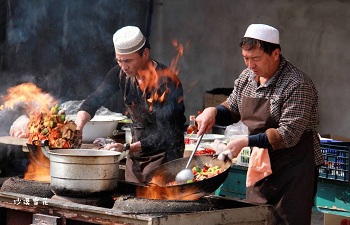
Tajik:
Tajik live in the eastern part of Pamirs, 3,000 metres above sea level. Every spring, they sow highland barley, pea, wheat and other cold-resistant crops. They move their herds to highland pastures in early summer, return to harvest the crops in autumn and then spend winter at home, leading a semi-nomadic life.
Men wear tall lambskin hats and collarless long jackets with belts, on top of which they add sheepskin overcoats in cold weather. Women wear dresses and their embroidered cotton-padded hats also have back flaps.
The Tajik herdsmen enjoy butter, sour milk, and other dairy products, and regard meat as a delicacy It is a taboo to eat pork. Most Tajik houses are square and fat-roof in structures and built with wood and stone. Since the high plateau is often assailed by snowstorms, the rooms are spacious but low. When herdsmen graze their herds in the mountains,they usually live in yurts or mud huts.The Tajik believes in Islamism. Except for the Islamic festivals, the Tajik Spring Festival, which falls in March, marks the beginning of a new year, which is the most important occasion for the Tajik people. The Tajik people pay great attention to etiquette and they are very hospitable. They ofter delicious stewed mutton( mutton eaten with hands rather than chopsticks), rice boiled by milk, buttered paste.
The Tajik people are brave and friendly. In Tajik's legends, eagle is a symbol of the hero. They like playing a short flute made with eagle-wing-bone and their dance is famous for imitating eagle's flying. Moreover, the Tajik people are known as their horsemanship. Their favourite sports ‘sheep tussling' and ‘Guapoq are clung to horse'.
Daur People:
Daurs form an ethnic nationality with long standing agricultural culture and a long history in the north China. "Daur" is the name with which the people of the Daur called themselves, meaning "cultivator". In the Qing Dynasty, Daurs were organized in the "Eight Banner System" and transferred to the frontier constantly, even as far as to Xinjiang. About 5 thousand of them are found in the Tacheng area and some them in Huocheng county and Urumqi. They are descendants of Daur soldiers who moved Tacheng in the time of Qing Dynasty.
Xibo:
In the mid 18 century, the Qing Court ordered to move them from northeastern China to Xiniiang to consolidate and reinforce the northwestern border defenses. These Xibos settled down in the Ili River Valley and made this area as their second hometown. With a population of 36,000 in Xinjiang, most of Xibe live in Qapal Xibe Autonomous county, Huocheng County and Gongliu County.
Xibo people believe in Shamanism and Tibetan Buddhism and they are pious worshipped of ancestors.
Rice and flour are staples for the Xibos. They like tea with milk, butter, cream, cheese and other dairy products. It is a taboo to eat donkey meat, horse meat and dog.
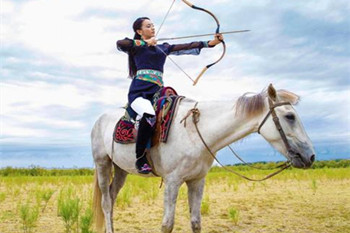
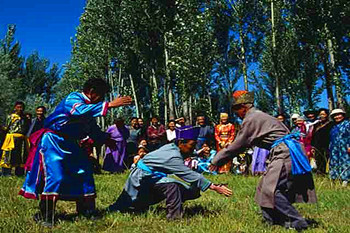
Tatar:
In 1920s to 1930s, Tatar in Xinjiang moved from Central Asia and Russia. With a population more than 5,000, they live in Yining, Tacheng, Urumqi snd other towns in southern Xinjiang,
The cultural life of the Tatars is quite rich and colorful. They love dramas, music and dances. Their dances are lively and cheerful and have their own characteristics. Several musical instruments are special for the Tatars, including the "Kunie"(a wooden fute), the"Kebisi"(a kind of harmonica), accordion and a two stringed violin.
The Tatars believe in Islamism. They celebrate Fast Breaking, the Corban Festival. The traditional festival is "Saban" Festival.
Manchu:
With a population of over18,000 in Xinjiang, Manchu people scatter in the vast land but mainly live in Ili, Changji and Urumqi. The majority of them are descendants of garrisoned "eight banner" battalions. Manchu soldiers were transferred by the Qing Court. Some immigrated from inland provinces. They have adopted conventions, customs as well as Mandarin as their spoken language. Most of Manchu people are engaged with education, hygiene and other businesses.
Uzbek:
The Uzbek ethnic nationality, with a population of more than 12,000, live in scattering way over a wide areas of the Xinjiang Uygur Autonomous Region. Most of them are city dwellers, some live in pastoral and rural area.
The Uzbek people believe in Islam, and they are good at singing and dancing and and their folk music is melodious and appealing. They have a great variety of musical instruments. Most of them are plucked and percussion instruments. One string instrument with a triangular sound box is known for its sweet and appealing tone. Uzbek dances are famous for their vivacity, grace and variety. Uzbek women are adept at embroidery Shirts, sheets, pillows and hats are trimmed with colorful, patterned needlework, which is typical of the handicraft art of the ethnic group.
